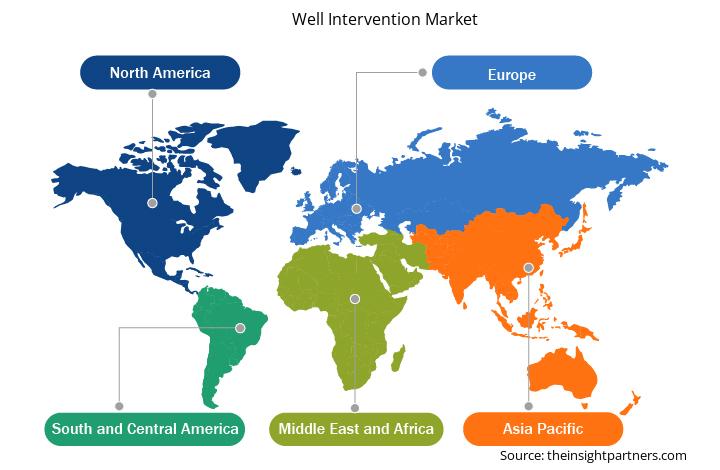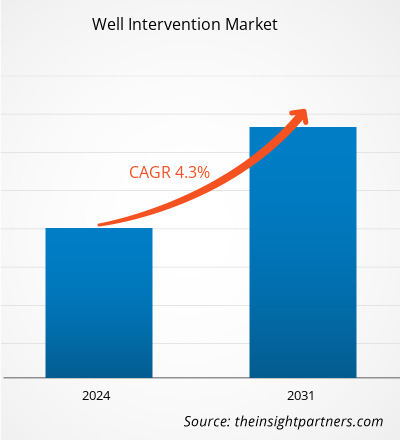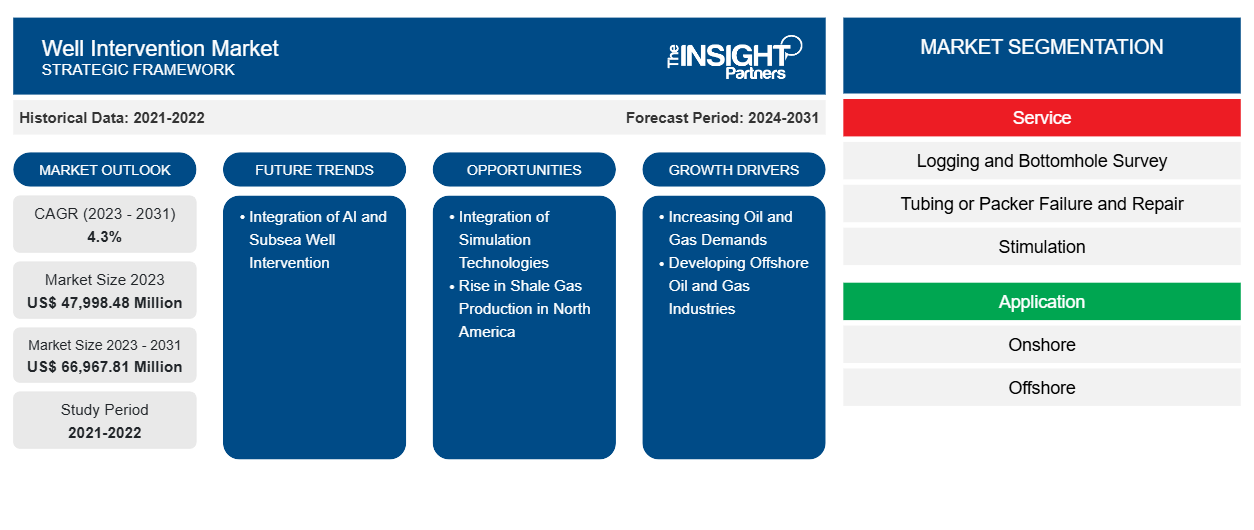La taille du marché des interventions sur puits devrait atteindre 66 967,81 millions USD d'ici 2031, contre 47 998,48 millions USD en 2023. Le marché devrait enregistrer un TCAC de 4,3 % au cours de la période 2023-2031. L'intégration de la technologie de l'intelligence artificielle (IA) et les interventions sur puits sous-marins devraient émerger comme de nouvelles tendances sur le marché dans les années à venir.
Analyse du marché des interventions sur les puits
Les principaux facteurs qui alimentent la croissance du marché des interventions sur les puits comprennent l'augmentation de la demande en pétrole et en gaz et le développement des industries pétrolières et gazières offshore. Cependant, le passage croissant des carburants conventionnels aux énergies renouvelables freine la croissance du marché des interventions sur les puits. Indépendamment des obstacles, l'intégration des technologies de simulation devrait créer des opportunités pour les principaux acteurs opérant sur le marché au cours de la période de prévision.
Aperçu du marché des interventions sur les puits
Les opérations d'intervention sur puits, ou travaux sur puits, sont réalisées pendant la vie active de tout puits de pétrole ou de gaz. Ces opérations sont initiées pour la réparation et l'entretien de l'infrastructure pendant sa vie active ou finale de production, dans le but probable de prolonger sa durée de vie. Ces opérations visent à superviser les processus de production du puits, à fournir des évaluations diagnostiques ou à modifier la construction ou l'état du puits. Les types de procédures d'intervention dépendent de l'équipement installé et de la conception de complétion à l'intérieur du puits de forage. Les opérations de maintenance telles que la diagraphie du puits de forage, le nettoyage , la réparation, le remplacement d'équipements cassés, la modification du puits pour améliorer la production et l'injection de fluides sont les domaines d'intérêt courants du travail d'intervention sur puits.
En fonction du type d'intervention, le marché des interventions sur puits est segmenté en interventions légères, moyennes et lourdes. Les techniciens déplacent les instruments ou les capteurs dans un puits actif lors d'interventions légères tout en maintenant la pression à la surface. En revanche, lors d'interventions lourdes, l'équipe de forage peut arrêter la production sur le site avant de procéder à des ajustements importants de l'équipement. En termes d'application, l'analyse du marché des interventions sur puits est basée sur les applications offshore et onshore. Ainsi, le nombre croissant de projets de forage onshore et offshore alimente le marché global.
Halliburton Co, Baker Hughes Co, Weatherford International Plc, Expro Group Holdings NV, Oceaneering International Inc, Archer Ltd, Schlumberger NV, Forum Energy Technologies Inc, Helix Energy Solutions Group Inc et Trican Well Service Ltd sont quelques-uns des principaux acteurs proposant des solutions d'intervention sur puits dans le monde entier. La recherche et le développement, ainsi que les alliances stratégiques avec des entreprises plus petites par le biais de fusions et d'acquisitions font partie des principales stratégies commerciales adoptées par les entreprises opérant sur le marché de l'intervention sur puits pour renforcer leur position sur le marché.
Personnalisez ce rapport en fonction de vos besoins
Vous bénéficierez d'une personnalisation gratuite de n'importe quel rapport, y compris de certaines parties de ce rapport, d'une analyse au niveau des pays, d'un pack de données Excel, ainsi que de superbes offres et réductions pour les start-ups et les universités.
-
Obtenez les principales tendances clés du marché de ce rapport.Cet échantillon GRATUIT comprendra une analyse de données, allant des tendances du marché aux estimations et prévisions.
Moteurs et opportunités du marché des interventions sur les puits
La demande croissante de pétrole et de gaz stimule la croissance du marché
Selon les informations fournies par l'Agence internationale de l'énergie en octobre 2024, la demande mondiale de pétrole devrait augmenter de 900 000 barils par jour (kb/j) en 2024 et de 1 million de barils par jour en 2025. La demande chinoise de pétrole brut a atteint un niveau record de 16 mb/j en mars 2023. L'invasion de l'Ukraine par la Fédération de Russie a menacé l'approvisionnement énergétique mondial avec une flambée des prix du pétrole et du gaz. En mai 2022, le Conseil européen a annoncé une interdiction partielle des importations de pétrole russe. Selon l'AIE, les pays européens ont importé 23 % de leur pétrole de Russie en 2021. L'approvisionnement en pétrole dans des endroits plus éloignés devrait maintenir les prix élevés. Les prix élevés du pétrole brut obligent les sociétés pétrolières et gazières à se concentrer sur une extraction de pétrole plus rentable et à augmenter les niveaux de production avec des techniques avancées telles que l'intervention sur les puits.
Les services d’intervention sur puits sont essentiels pour l’industrie pétrolière et gazière, car ils contribuent à maintenir la productivité des puits de pétrole et de gaz terrestres et offshore. Négliger l’état des puits peut entraîner une baisse des résultats de production, ce qui se traduit à terme par des pertes financières pour l’entreprise, ainsi que pour les économies nationales. Une intervention précoce sur les puits est donc essentielle pour garantir la productivité et la rentabilité des puits. Ses avantages comprennent des taux de production plus élevés, une sécurité améliorée et une réduction des dépenses associées à la maintenance différée. D’un autre côté, négliger l’entretien des puits matures peut augmenter le risque de dommages ou de pannes de l’équipement, ce qui peut entraîner des risques pour la sécurité et des réparations coûteuses. Par conséquent, la demande de services d’intervention sur puits augmente avec le besoin croissant de pétrole et de gaz dans le monde, car ces services contribuent à la production optimale des puits de pétrole et de gaz.
Intégration des technologies de simulation pour générer des opportunités de croissance dans le futur
L’intégration de simulateurs d’intervention sur puits apporte de nombreux avantages à l’industrie pétrolière et gazière. Ces simulateurs jouent un rôle essentiel dans la réduction des risques d’accidents en permettant aux opérateurs pétroliers et gaziers de perfectionner leurs compétences dans un environnement sans risque. Ils contribuent également à une plus grande efficacité opérationnelle en fournissant aux opérateurs une plateforme pour affiner leurs techniques et leurs stratégies. De plus, la technologie des jumeaux numériques, qui crée des représentations virtuelles d’actifs et de processus physiques, devient de plus en plus cruciale dans les interventions sur puits sous-marins. Les jumeaux numériques fournissent des informations en temps réel sur les performances des puits et permettent aux ingénieurs de simuler et d’optimiser les opérations d’intervention. En utilisant des jumeaux numériques, les ingénieurs peuvent tester différents scénarios d’intervention, identifier les risques potentiels et optimiser le flux de travail. Ces tests virtuels minimisent le besoin de tests physiques et permettent d’économiser du temps et des ressources tout en améliorant la sécurité et l’efficacité des opérations sur puits sous-marins. De plus, ces simulateurs logiciels facilitent l’amélioration de la qualité globale des interventions sur puits tout au long du cycle de vie du puits. Ils permettent aux opérateurs d’identifier les problèmes potentiels et d’évaluer diverses stratégies d’intervention avant de les mettre en œuvre dans des scénarios réels. Ils contribuent non seulement à des économies de temps et d’argent, mais augmentent également la sécurité et l’efficacité des actifs. De plus, les industries pétrolières et gazières peuvent relever de manière proactive les défis associés aux opérations d’intervention sur puits et garantir des performances optimales grâce à des processus perfectionnés, améliorant ainsi la durabilité et le succès des opérations pétrolières et gazières. Ainsi, l’intégration des technologies de simulation devrait apporter d’importantes opportunités de croissance sur le marché des interventions sur puits dans les années à venir.
Analyse de segmentation du rapport sur le marché des interventions sur puits
Les segments clés qui ont contribué à l’élaboration de l’analyse du marché des interventions sur les puits sont le service, l’application, l’intervention et le type de puits.
- En fonction du service, le marché mondial des interventions sur les puits est segmenté en diagraphie et étude de fond de puits, défaillance et réparation de tubes/packers et stimulation. Le segment de la diagraphie et de l'étude de fond de puits détenait la plus grande part de marché en 2023.
- En fonction des applications, le marché est divisé en onshore et offshore. Le segment onshore détenait une part de marché plus importante en 2023.
- En fonction de l'intervention, le marché est divisé en segments léger, moyen et lourd. Le segment léger détenait la plus grande part du marché en 2023.
- En fonction du type de puits, le marché est divisé en horizontal et vertical. Le vertical détenait une part plus importante du marché en 2023.
Analyse des parts de marché des interventions sur puits par zone géographique
Français La portée géographique du rapport sur le marché des interventions sur puits est principalement divisée en cinq régions : Amérique du Nord, Asie-Pacifique, Europe, Moyen-Orient et Afrique et Amérique du Sud. L'Amérique du Nord a dominé le marché des interventions sur puits en 2023 avec une part de 36,7 % ; elle devrait continuer à dominer au cours de la période de prévision et représenter 36,0 % d'ici 2031. Les États-Unis, le Canada et le Mexique sont les principales économies d'Amérique du Nord. La région est l'un des principaux exportateurs de pétrole et de gaz au monde. Les États-Unis représentaient plus de 18 % de la production mondiale de pétrole en 2023, avec la présence d'un grand nombre de champs pétroliers onshore et offshore à travers le pays. Les États-Unis et le Canada, ensemble, produisent plus de pétrole et de gaz que toute autre région du monde. De plus, leurs volumes de production sont bien supérieurs à leurs niveaux de consommation. Les volumes élevés soulignent la capacité de production dynamique tirée par des sources de pétrole et de gaz non conventionnelles, notamment le pétrole de schiste, le gaz de schiste et les sables bitumineux canadiens. Les pays d’Amérique du Nord génèrent donc une vaste demande en équipements et services d’intervention sur puits.
Aperçu régional du marché des interventions sur les puits
Les tendances régionales et les facteurs influençant le marché des interventions sur puits tout au long de la période de prévision ont été expliqués en détail par les analystes d'Insight Partners. Cette section traite également des segments et de la géographie du marché des interventions sur puits en Amérique du Nord, en Europe, en Asie-Pacifique, au Moyen-Orient et en Afrique, ainsi qu'en Amérique du Sud et en Amérique centrale.

- Obtenez les données régionales spécifiques au marché des interventions sur les puits
Portée du rapport sur le marché des interventions sur puits
| Attribut de rapport | Détails |
|---|---|
| Taille du marché en 2023 | 47 998,48 millions de dollars américains |
| Taille du marché d'ici 2031 | 66 967,81 millions de dollars américains |
| Taux de croissance annuel composé mondial (2023-2031) | 4,3% |
| Données historiques | 2021-2022 |
| Période de prévision | 2024-2031 |
| Segments couverts |
Par service
|
| Régions et pays couverts |
Amérique du Nord
|
| Leaders du marché et profils d'entreprises clés |
|
Densité des acteurs du marché des interventions sur puits : comprendre son impact sur la dynamique des entreprises
Le marché des interventions sur puits connaît une croissance rapide, tirée par la demande croissante des utilisateurs finaux en raison de facteurs tels que l'évolution des préférences des consommateurs, les avancées technologiques et une plus grande sensibilisation aux avantages du produit. À mesure que la demande augmente, les entreprises élargissent leurs offres, innovent pour répondre aux besoins des consommateurs et capitalisent sur les tendances émergentes, ce qui alimente davantage la croissance du marché.
La densité des acteurs du marché fait référence à la répartition des entreprises ou des sociétés opérant sur un marché ou un secteur particulier. Elle indique le nombre de concurrents (acteurs du marché) présents sur un marché donné par rapport à sa taille ou à sa valeur marchande totale.
Les principales entreprises opérant sur le marché des interventions sur puits sont :
- Compagnie Halliburton
- Compagnie Baker Hughes
- Weatherford International Plc
- Expro Group Holdings NV
- Oceaneering International Inc
- Archer Ltée
Avis de non-responsabilité : les sociétés répertoriées ci-dessus ne sont pas classées dans un ordre particulier.

- Obtenez un aperçu des principaux acteurs clés du marché des interventions sur puits
Actualités et développements récents du marché des interventions sur puits
Le marché des interventions sur les puits est évalué en collectant des données qualitatives et quantitatives après des recherches primaires et secondaires, qui comprennent d'importantes publications d'entreprise, des données d'association et des bases de données. Quelques-uns des développements sur le marché des interventions sur les puits sont énumérés ci-dessous :
- Expro a acquis Coretrax, un leader technologique dans les outils de forage de performance et le nettoyage des puits, auprès de Buckthorn Partners. (Expro, communiqué de presse, 2024)
- Baker Hughes a finalisé l'acquisition d'Altus Intervention, spécialiste norvégien des interventions sur puits, qui opère dans 11 pays. (Baker Hughes, communiqué de presse, 2023)
- CeraPhi Energy, Royaume-Uni, a signé un accord exclusif avec Halliburton pour des services de forage et d'intervention sur puits en échange d'un soutien en nature en matière d'ingénierie et de gestion de projet. (CeraPhi Energy, communiqué de presse, 2022)
Rapport sur le marché des interventions sur les puits et livrables
Le rapport « Well Intervention Market Size and Forecast (2021-2031) » fournit une analyse détaillée du marché couvrant les domaines ci-dessous :
- Taille et prévisions du marché des interventions sur puits aux niveaux mondial, régional et national pour tous les segments de marché clés couverts par le champ d'application
- Tendances du marché des interventions sur puits, ainsi que la dynamique du marché, comme les facteurs moteurs, les contraintes et les opportunités clés
- Analyse PEST et SWOT détaillée
- Analyse du marché des interventions sur puits couvrant les principales tendances du marché, le cadre mondial et régional, les principaux acteurs, les réglementations et les développements récents du marché
- Analyse du paysage industriel et de la concurrence couvrant la concentration du marché, l'analyse de la carte thermique, les principaux acteurs et les développements récents pour le marché des interventions sur puits
- Profils d'entreprise détaillés
- Analyse historique (2 ans), année de base, prévision (7 ans) avec TCAC
- Analyse PEST et SWOT
- Taille du marché Valeur / Volume - Mondial, Régional, Pays
- Industrie et paysage concurrentiel
- Ensemble de données Excel
Rapports récents
Témoignages
Raison d'acheter
- Prise de décision éclairée
- Compréhension de la dynamique du marché
- Analyse concurrentielle
- Connaissances clients
- Prévisions de marché
- Atténuation des risques
- Planification stratégique
- Justification des investissements
- Identification des marchés émergents
- Amélioration des stratégies marketing
- Amélioration de l'efficacité opérationnelle
- Alignement sur les tendances réglementaires























 Obtenez un échantillon gratuit pour - Marché des interventions sur puits
Obtenez un échantillon gratuit pour - Marché des interventions sur puits